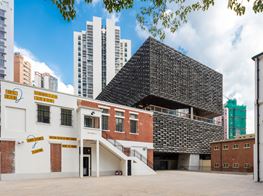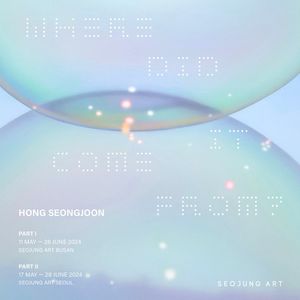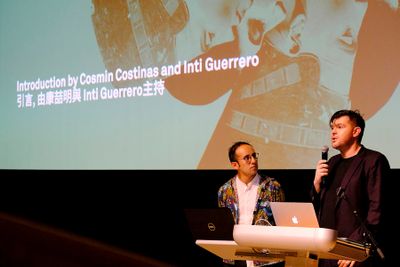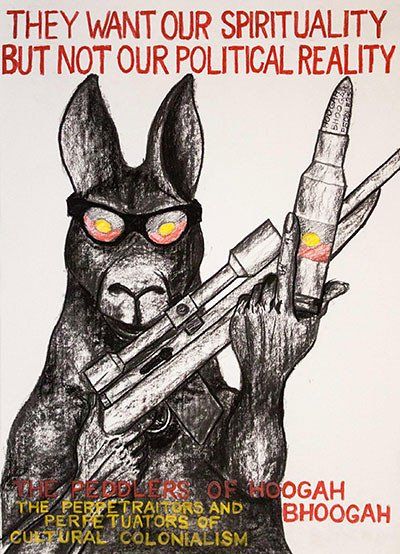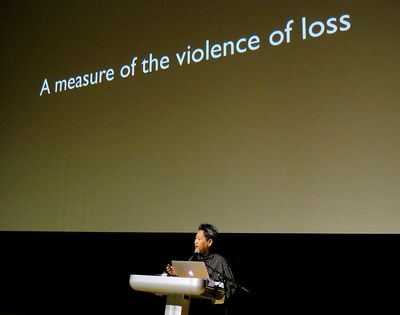Para Site Conference: Heritage and Dis/Possession
For Para Site's 2018 edition of its International Conference, titled What to let go? (22–24 November 2018), Hong Kong's longest-running contemporary art space turned its focus to the politics of heritage. Hosted at Tai Kwun – Centre for Heritage and Arts, and led by Para Site director Cosmin Costinas together with guest curator Inti Guerrero, the programme brought together a broad mix of artists, curators, museum professionals and scholars from across Asia and further afield. The three-day programme also coincided with the delivery of Felwyn Sarr and Bénédicte Savoy's so-called 'Restitution Report', commissioned by French President Emmanuel Macron and fully titled 'The Restitution of African Cultural Heritage. Toward a New Relational Ethics'.
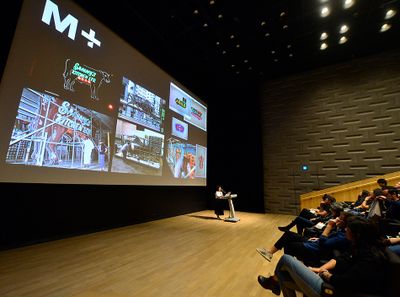
Naman P. Ahuja at What to Let Go?, Para Site International Conference, Tai Kwun – Centre for Heritage and Arts, Hong Kong (22–24 November 2018). Courtesy Para Site. Photo: Eddie Lam, Image Art Studio.
The implications of 'relational ethics' emerged on the first day of the conference, when the New Delhi scholar and curator Naman P. Ahuja took the audience through a tour-de-force of the minutiae involved in staging large, publicly focused exhibitions in India featuring significant loans from United Kingdom collections. As part of his talk, and in stressing the kinds of labour required, Ahuja included an email fragment in one of his slides. Although redacted and blurred, it was possible to discern a lengthy and delicate explanation to British colleagues as to why a particular word had local sensitivity and might not be the best to use in official communications.
On the second day, Philippine scholar and activist Marian Pastor Roces offered a barn-storming consideration of the dizzying array of Philippine weaponry held in colonial collections across the world—and the significance of a nation's capacity to own its legacies of violence in the fullest sense. As a side note, Pastor Roces also mentioned an enormous and admirable but ultimately failed labour of hers to devise an accession record system that would permit textile works to be indexed by the verbs of their proper titles, rather than by the nouns of ethnographic taxonomies.
Both these conference high-points bring home the crucial insight that exchange is not a neutral transfer of property. An exchange produces categories of relation; including—perhaps most significantly—the species of exchange that is dispossession.
To understand something of dispossession as a production created by asymmetrical exchange, we might look to the work of Goenpul scholar Aileen Moreton-Robinson and the epistemological framework she names 'the white possessive' in her 2015 book The White Possessive: Property, Power, and Indigenous Sovereignty. The white possessive appears in many guises, and certainly expresses itself fully through European imperial collections. To hone in on what she means by this term, Moreton-Robinson turns to arguments made against Indigenous land rights in Australia in the early 2000s during Prime Minister John Howard's tenure. In particular, she cites the arguments of Keith Windschuttle (found in his The Fabrication of Aboriginal History, Volume One), an Australian historian and Howard acolyte who contended that because Indigenous languages do not have words that express property in the terms of modern European law, and do not evidence a notion of land as alienable and transferrable property, Indigenous people therefore cannot be recognised as land-title owners by the Australian state.
This paradoxical two-step logic of the white possessive is squarely given the label of 'Hoogah-Boogah' by Waanyi artist Gordon Hookey, whose work most recently became known to international audiences through its inclusion in the 2017 documenta 14. Well known for his use of text within vast, figurative paintings of Indigenous Australian resistance, Hookey often returns to a particular formulation on the extractive politics of cultural value. It goes: 'They want our spirituality, but not our political reality. The peddlers of Hoogah Boogah. The perpetrators and perpetuators of cultural colonialism.' These incisive phrases are densely packed with insights into the technicity of dispossession as a cultural matrix. Foremost among them is the revelation that 'Hoogah Boogah' is a product and a feature of the colonial culture itself.
The profound significance of dispossession as a marker of European modernity has also recently been examined in-depth by political scientist Robert Nichols in his incisive 2017 paper 'Theft Is Property! The Recursive Logic of Dispossession', published in the journal Political Theory. Nichols forensically reviews the use of the term dispossession within 18th-and 19th-century European critiques of feudal land tenure. Citing Rousseau, Proudhon, Kropotkin and Marx, among others, Nichols notes the tendency within European theory to presuppose an originary idea of possession even while staging a critique of capital, and thereby the tendency to reinforce a proprietary model of social relations. Nichols calls this the 'recursive logic of property', in a vein that is similar to Moreton-Robinson's 'the white possessive'. The paper then shifts gears to study the work of a number of Indigenous scholars from Anglophone settler-colonial contexts including Aileen Moreton-Robinson, Mohawk legal scholar Patricia Monture-Angus and Lakota (Standing Rock Sioux) philosopher Vine Deloria Jr. Among these writers, Nichols finds a much more complex and consequent meaning of dispossession, marked by a transformation of land into property.
These theoretical positions might appear abstract until they find real-world manifestations; for example within the taxonomies and pragmatic operations of European museum collections. In my own work, I have encountered this in establishing and collaborating with the 'As Long As It Takes!' acquisition advisory group. Through collaborative meetings, the group has identified three exchange modes by which Dutch museums have historically alienated non-European communities from cultural value. The first is by acquiring cultural treasures into collections through colonial plunder; the second is by failing to recognise vast areas of artistic practice as vital, innovative and significant to modern times; and the third is where non-European art has been legitimately acquired into collections at prices significantly lower than those for ethnically European work. The response of 'As Long As It Takes!' has been to form an acquisition advisory body comprised of representatives of the Bijlmer Parktheatre, the HipHopHuis and the University of Colour—significant cultural institutions that include Dutch-based ZMV (zwart, migrantie en vluchtlingen)—black, migrant and refugee communities. 'As Long As It Takes!' has found a supportive partner in the Van Abbemuseum, and over two years' of negotiation it has become clear that much of what the museum will 'acquire' is not so much one art object or another, but rather knowledges, custodial skills, relationships and relevance to communities that to-date have had little reason to be museum visitors.
Returning to Para Site's question of 'What to let go?', one of the benefits of staging the conference in Hong Kong was the possibility to relativise the colonial axis of Europe versus 'other'. From the standpoint of East Asia it is not hard to imagine a future in which European leaders might consider projects of restitution in order to secure trade deals with rising southern economies. It is also not difficult to imagine that China could lend its coercive weight to restitution agendas in seeking to promote an image of itself as champion and friend to formerly colonised states, whatever its larger agenda may be. European disavowals such as hand-wringing over the capacity of humankind to stage universal surveys if works are dispersed, or questions as to the ability of societies to care for their own treasures may well transpire as simply more Hoogah Boogah.
The question of European museum restitution is re-cast in this light, not so much a matter of 'if' or 'when', but 'how'? Considering the examples given by Ahuja and Roces above, it is a question that asks whether European institutions are prepared to engage in the vast labour of their own transformation. In the meantime, non-European states and societies could well care less about whether western liberal democracies will overcome their paroxysms of reactionary torpor. Viewed through this lens of global transformation, it seems that the cultural authorities of Western Europe—and their settler-colonial counterparts such as Australia and the United States—would be mad not to take the opportunity for restitution that the current historical juncture allows. History, however, would show that a certain reality-disavowing madness is a long-standing colonial trait. Overcoming this in itself may be much of the labour of letting go.—[O]

